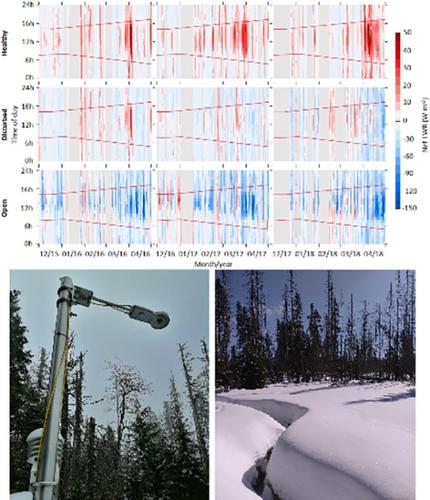当前位置:
X-MOL 学术
›
Hydrol. Process.
›
论文详情
Our official English website, www.x-mol.net, welcomes your
feedback! (Note: you will need to create a separate account there.)
The impact of changing subcanopy radiation on snowmelt in a disturbed coniferous forest
Hydrological Processes ( IF 2.8 ) Pub Date : 2020-10-11 , DOI: 10.1002/hyp.13936 Ondrej Hotovy 1 , Michal Jenicek 1
Hydrological Processes ( IF 2.8 ) Pub Date : 2020-10-11 , DOI: 10.1002/hyp.13936 Ondrej Hotovy 1 , Michal Jenicek 1
Affiliation

|
Understanding the role of forests on snowmelt processes enables better estimates of snow storages at a catchment scale and contributes to a higher accuracy of spring flood forecasting. A coniferous forest modifies the snowpack energy balance by reducing the total amount of solar shortwave radiation (SWR) and enhancing the role of longwave radiation (LWR) emitted by trees. This study focuses on changes in SWR and LWR at three sites with different canopy structure (Bohemian Forest, Czechia), including one site affected by the bark beetle (Ips typographus). Measurements of incoming and outgoing SWR and LWR were performed at all sites equipped with CNR4 Net Radiometers for three cold seasons. In addition to SWR and LWR, sensible and latent heat, and ground heat and energy supplied by liquid precipitation were calculated. The results showed that net SWR at the healthy forest site represented only 7% of the amount at the open site due to the shading effect of trees. In contrast, net LWR represented a positive component of the snowpack energy balance at the healthy forest site and thus contributed the most to snowmelt. However, the modelled snowmelt rates were significantly lower in the forest than in the open area since the higher LWR in the forest did not compensated for the lower SWR. The progressive decay of disturbed forest caused the decrease in mean net LWR from −3.1 W/m2 to −12.9 W/m2 and the increase in mean net SWR from 31.6 W/m2 to 96.2 W/m2 during the study period. These changes caused an increase in modelled snowmelt rates by 50% in the disturbed forest, compared to the healthy forest site, during the study period. Our findings have important implications for runoff from areas affected by land cover changes due to either human activity or climate change.
中文翻译:

冠层次生辐射变化对针叶林融雪的影响
了解森林在融雪过程中的作用,可以更好地估算集水区的积雪量,并有助于提高春季洪水预报的准确性。针叶林通过减少太阳短波辐射(SWR)的总量并增强树木发出的长波辐射(LWR)的作用来改变积雪的能量平衡。这项研究的重点是在具有不同冠层结构的三个地点(捷克波西米亚森林)的SWR和LWR的变化,包括一个受树皮甲虫影响的地点(Ips typographus)。在装有CNR4净辐射计的所有站点进行了三个寒冷季节的进站SWR和LWR的测量。除SWR和LWR外,还计算了显热和潜热以及地热和液体沉淀提供的能量。结果表明,由于树木的遮荫作用,健康林地的净SWR仅占开阔地的7%。相反,净轻水堆代表了健康森林站点积雪能量平衡的积极组成部分,因此对融雪贡献最大。但是,由于森林中较高的LWR不能补偿较低的SWR,因此在森林中模拟的融雪率显着低于开放区域。扰动森林的逐步衰退导致平均净LWR从-3.1 W / m下降2至-12.9 W /米2和在平均净SWR的增加从31.6瓦/米2至96.2瓦/米2,在研究期间。在研究期间,与健康森林站点相比,这些变化导致受干扰森林的模拟融雪率提高了50%。我们的发现对人类活动或气候变化引起的土地覆盖变化影响地区的径流具有重要意义。
更新日期:2020-10-22
中文翻译:

冠层次生辐射变化对针叶林融雪的影响
了解森林在融雪过程中的作用,可以更好地估算集水区的积雪量,并有助于提高春季洪水预报的准确性。针叶林通过减少太阳短波辐射(SWR)的总量并增强树木发出的长波辐射(LWR)的作用来改变积雪的能量平衡。这项研究的重点是在具有不同冠层结构的三个地点(捷克波西米亚森林)的SWR和LWR的变化,包括一个受树皮甲虫影响的地点(Ips typographus)。在装有CNR4净辐射计的所有站点进行了三个寒冷季节的进站SWR和LWR的测量。除SWR和LWR外,还计算了显热和潜热以及地热和液体沉淀提供的能量。结果表明,由于树木的遮荫作用,健康林地的净SWR仅占开阔地的7%。相反,净轻水堆代表了健康森林站点积雪能量平衡的积极组成部分,因此对融雪贡献最大。但是,由于森林中较高的LWR不能补偿较低的SWR,因此在森林中模拟的融雪率显着低于开放区域。扰动森林的逐步衰退导致平均净LWR从-3.1 W / m下降2至-12.9 W /米2和在平均净SWR的增加从31.6瓦/米2至96.2瓦/米2,在研究期间。在研究期间,与健康森林站点相比,这些变化导致受干扰森林的模拟融雪率提高了50%。我们的发现对人类活动或气候变化引起的土地覆盖变化影响地区的径流具有重要意义。











































 京公网安备 11010802027423号
京公网安备 11010802027423号